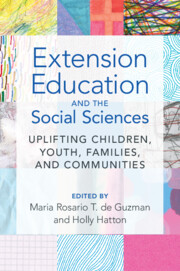Book contents
- Extension Education and the Social Sciences
- Extension Education and the Social Sciences
- Copyright page
- Contents
- Contributors
- Part I Overview of Extension and the Social Sciences
- Chapter 1 Introduction
- Chapter 2 Engaged Scholarship
- Chapter 3 Extension’s Role in Promoting Resilience among Rural Families with Low Incomes
- Chapter 4 Extension Programming to Enhance Urban Well-Being
- Part II Addressing Key Issues in the Well-Being of Children, Youth, and Families
- Part III Looking Ahead: Emerging Issues and Trends
- Index
- References
Chapter 3 - Extension’s Role in Promoting Resilience among Rural Families with Low Incomes
from Part I - Overview of Extension and the Social Sciences
Published online by Cambridge University Press: 28 March 2024
- Extension Education and the Social Sciences
- Extension Education and the Social Sciences
- Copyright page
- Contents
- Contributors
- Part I Overview of Extension and the Social Sciences
- Chapter 1 Introduction
- Chapter 2 Engaged Scholarship
- Chapter 3 Extension’s Role in Promoting Resilience among Rural Families with Low Incomes
- Chapter 4 Extension Programming to Enhance Urban Well-Being
- Part II Addressing Key Issues in the Well-Being of Children, Youth, and Families
- Part III Looking Ahead: Emerging Issues and Trends
- Index
- References
Summary
Rural communities. Rural families. Both face challenges and opportunities for viability and security. The Rural Families Speak Project has been studying rural families with low incomes for over twenty years, listening to the voices of families and sharing their stories of challenges as well as resiliency with policymakers and community educators. Select findings of this rich body of work focused on four domains – food insecurity, economic security, health, and family well-being – and are shared in this chapter along with implications and recommendations for community outreach and education. In particular, the roles that Extension can play in serving rural communities and families are presented. This chapter illustrates the translational linkage between research and Extension work highlighting the importance of integrating research and practice.
- Type
- Chapter
- Information
- Extension Education and the Social SciencesUplifting Children, Youth, Families, and Communities, pp. 40 - 63Publisher: Cambridge University PressPrint publication year: 2024

